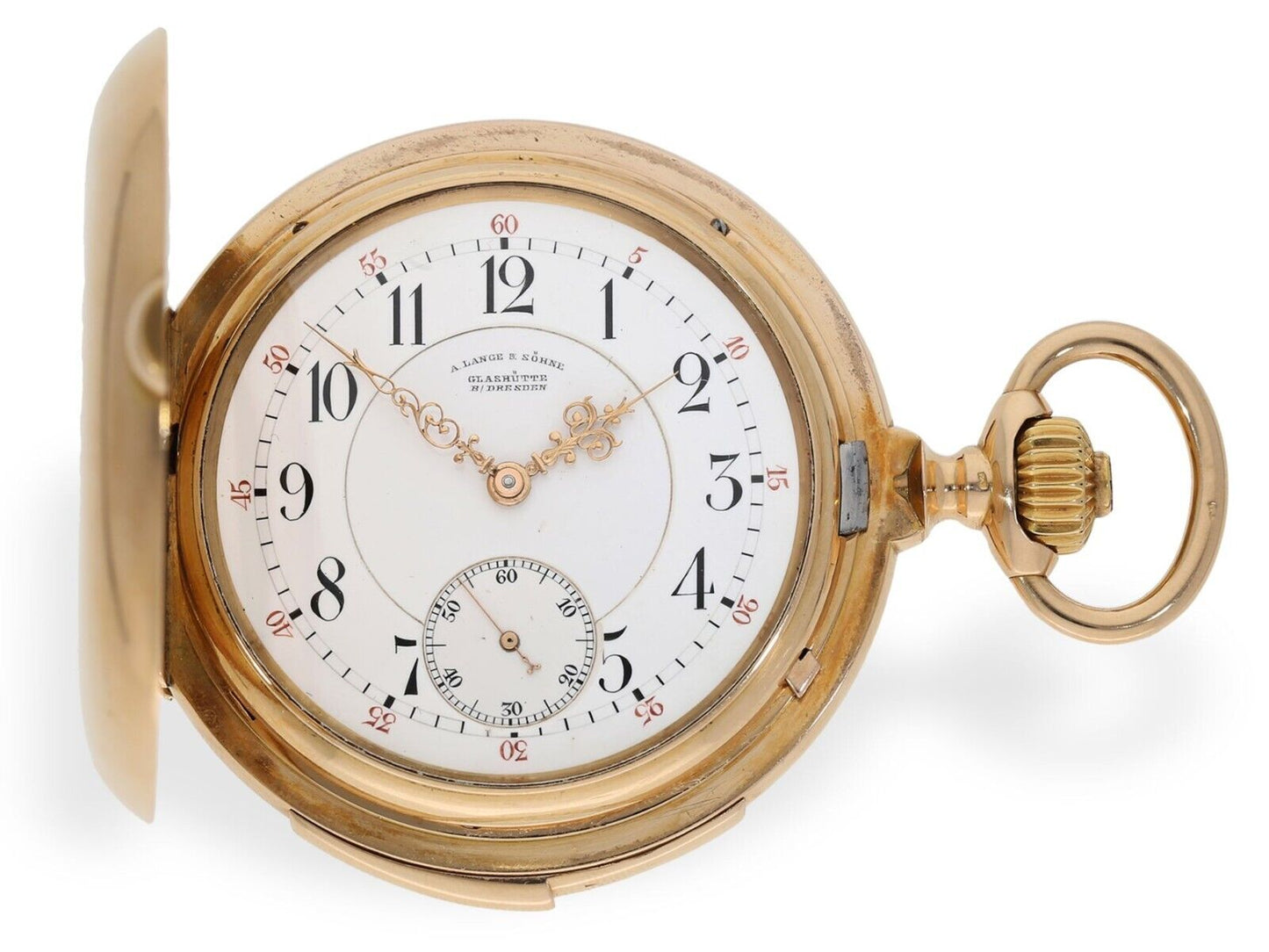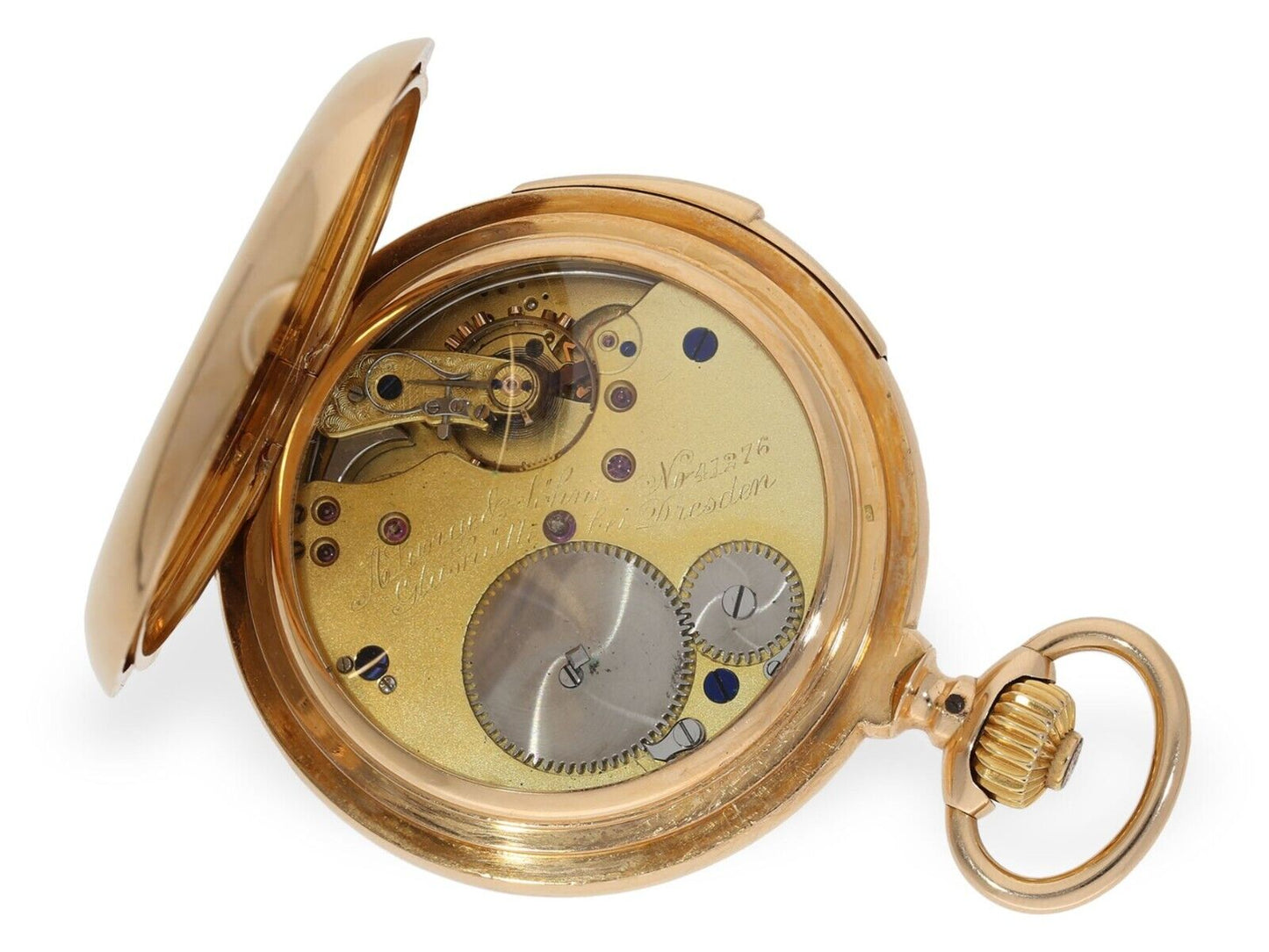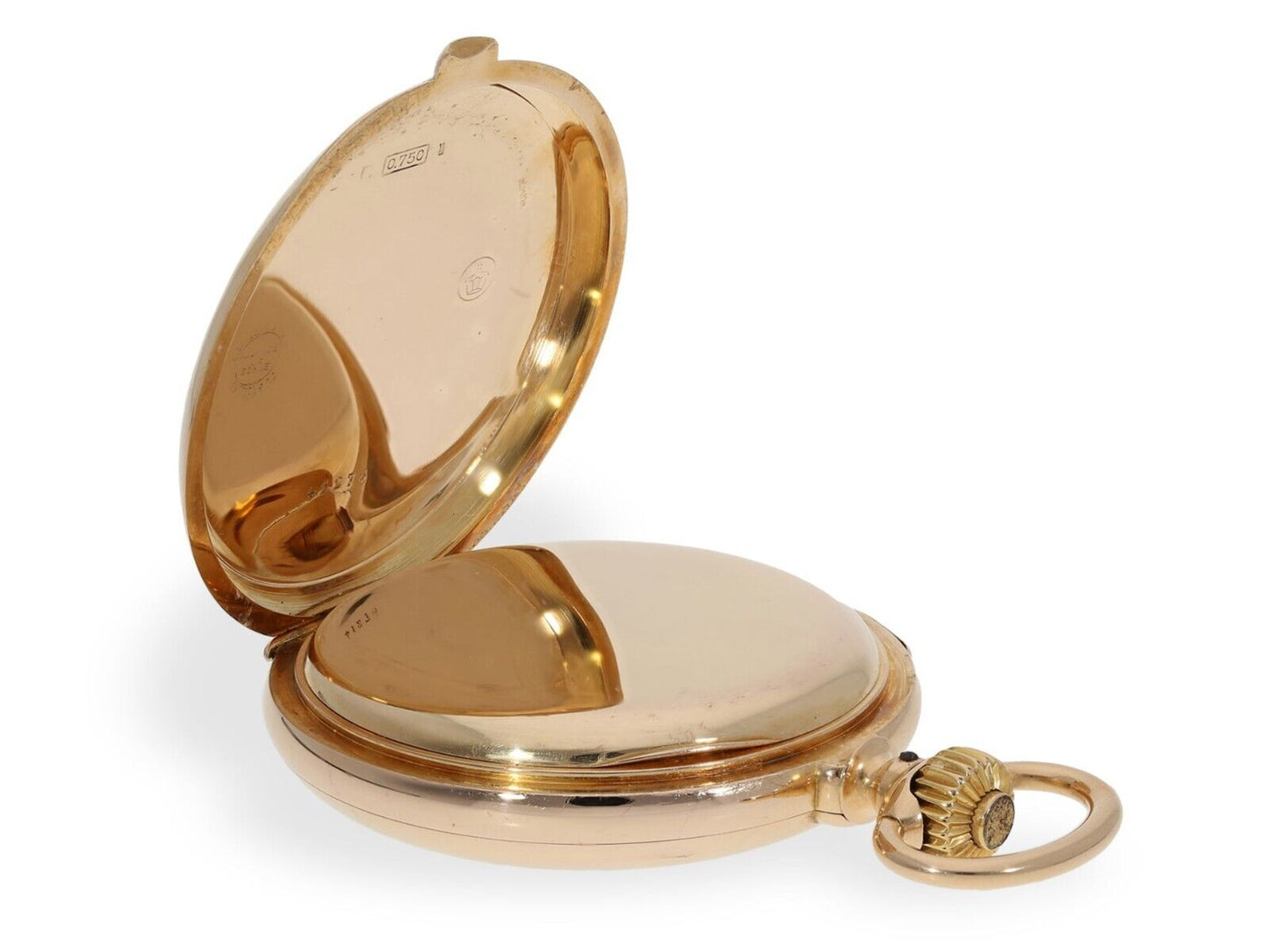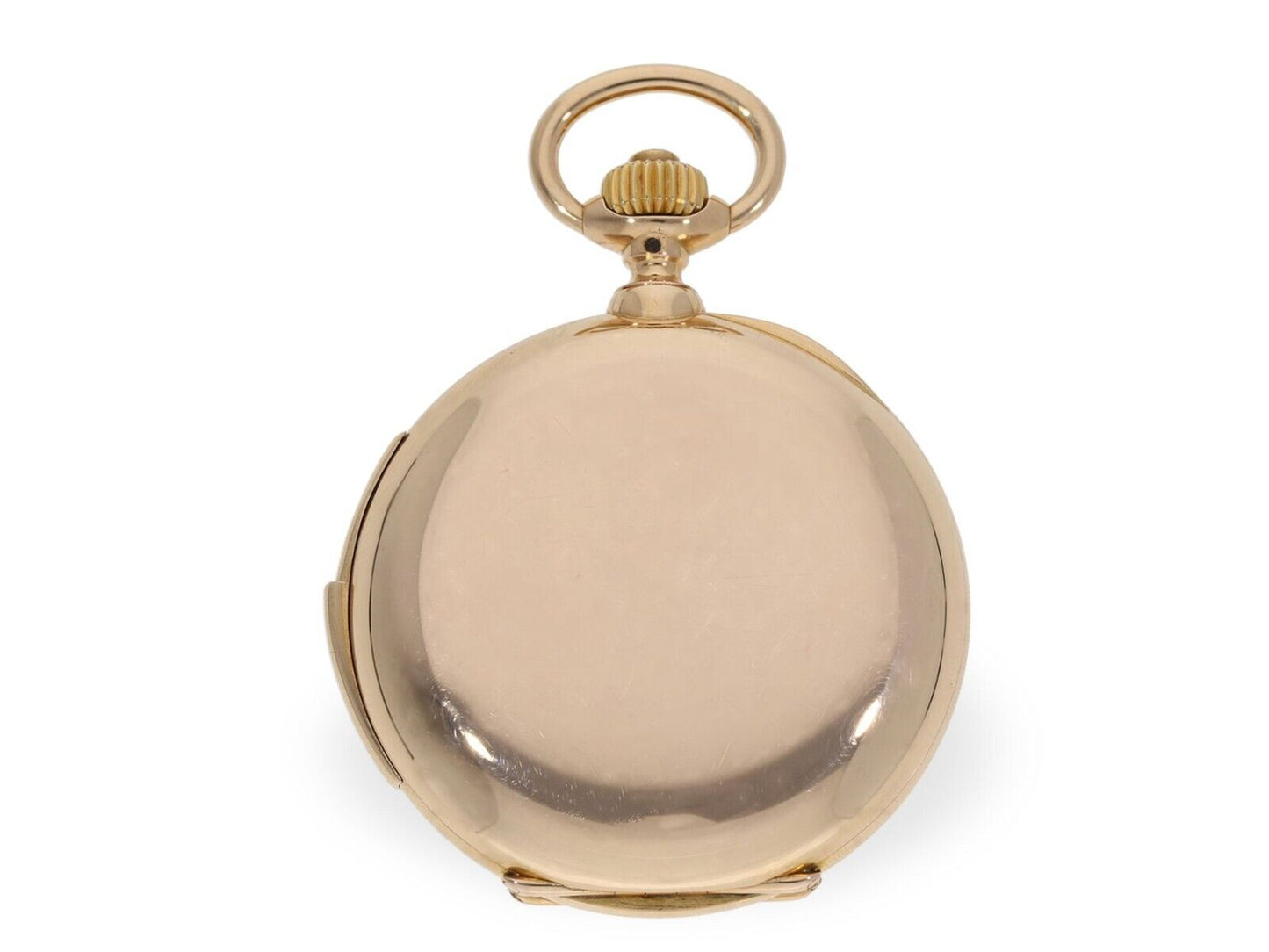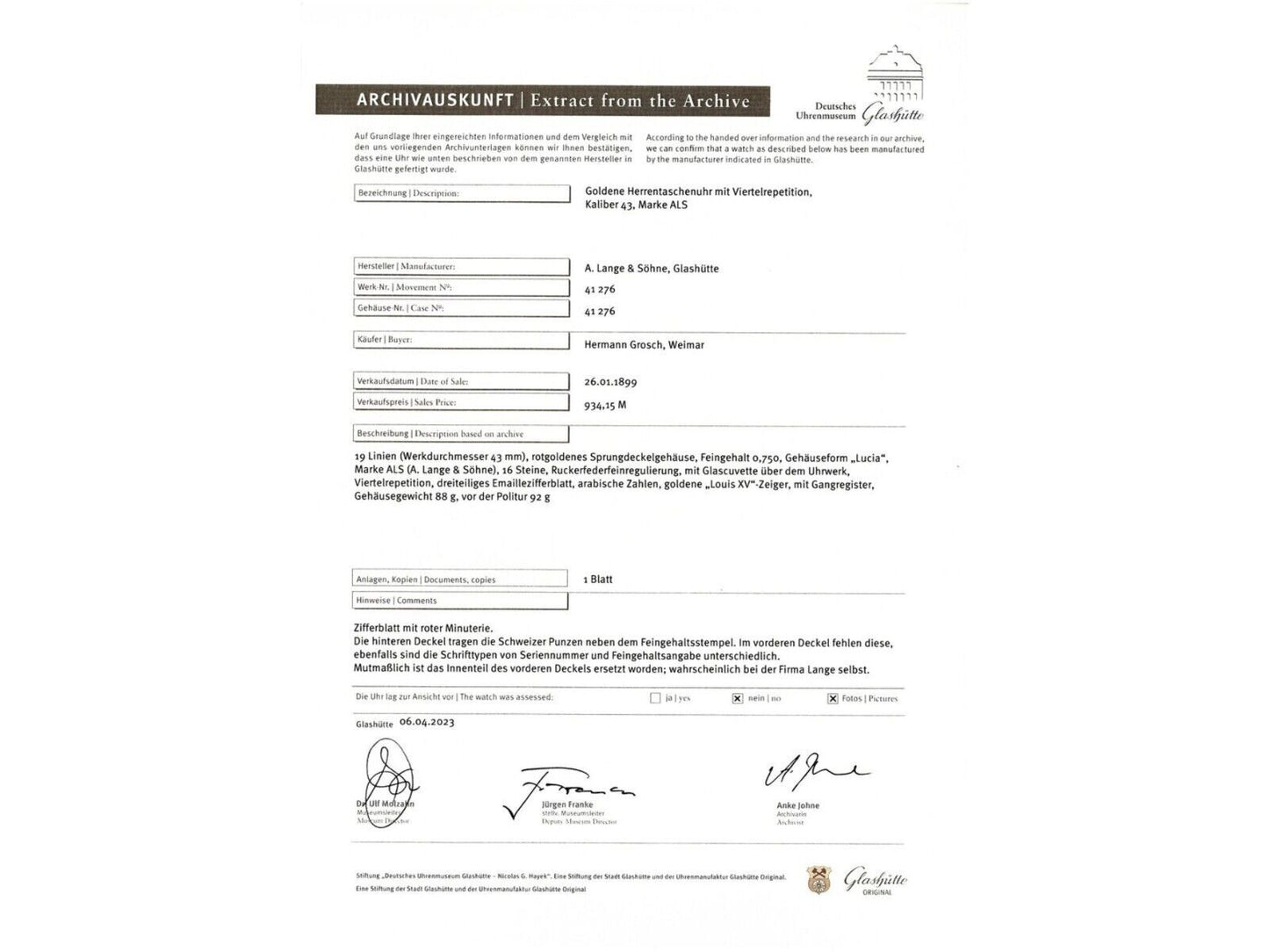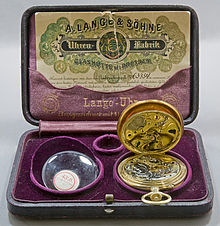A. Lange & Söhne
Quarter repeater A. Lange & Söhne 0.750 18K gold rarest men's pocket watch
Quarter repeater A. Lange & Söhne 0.750 18K gold rarest men's pocket watch
Couldn't load pickup availability
Absolute rarity and museum collector’s item:
A. Lange & Söhne Glashütte / Dresden solid 750 18K gold men's pocket watch with very rare quarter repeater and extract from the archives
Lange & Söhne only produced a few hundred quarter-repeating pocket watches, and most of them ended up in the meltdown during two world wars and various economic crises.
Absolutely original and authentic, movement and case number identical, archive extract from the Glashütte Watch Museum proving authenticity is included (see photos)
Description:
Large and heavy A. Lange & Söhne gold savonnette with quarter-hour repeater, Glashütte 1899
Case diameter: 55.5mm, approx. 142g, 18K gold, savonnette with three gold lids, movement glazed, case and movement number matching 41276
A. Lange & Söhne precision lever movement with fine adjustment, gold lever, gold escape wheel, and gold screw balance, excellently preserved original enamel dial with red minute track, red gold hands, excellent condition, functional
The extract from the archives confirms the originality of the watch, which was delivered to Hermann Grosch in Weimar in 1899. Due to a minimal discrepancy in the Lange hallmarks between the back cover and the spring-loaded case, it is assumed that the inner part of the spring-loaded case was replaced by Lange and Söhne during a service. The reason is likely a dedication that was to be removed. This change is not visually visible but is noted in the extract from the archives.
This magnificent piece of watch history runs continuously (accuracy not tested)
EZ: 1 - barely noticeable signs of age or wear, dial unrestored flawless, high-precision movement sparkling clean, all lids close tightly and flush, the magnificent artifact starts and runs
History of the best German watch manufacturer "Lange&Söhne" Glashütte (Source: Wikipedia):
A. Lange & Söhne
| Lange Uhren GmbH | |
|---|---|
| Legal form | Limited liability company |
| Founding | 1845 / 1990 |
| seat | Glassworks , |
| Line | Wilhelm Schmid |
| Number of employees | 750 (worldwide) [1] |
| Industry | watch manufacturer |
A. Lange & Söhne is now the registered trademark of the German watch manufacturer Lange Uhren GmbH from Glashütte , Saxony . Lange Uhren GmbH, in turn, belongs to the Richemont Group.
History
From 1845

On December 7, 1845, the Saxon watchmaker Ferdinand Adolph Lange , a student and son-in-law of the Saxon court watchmaker Johann Christian Friedrich Gutkaes senior , founded the watch manufactory "A. Lange & Cie." in Glashütte near Dresden. In an early example of state structural policy, Lange received 7,800 thalers for the founding of the company and for the training of 15 apprentices in the structurally weak Glashütte near Dresden, as financial aid from the Royal Saxon Ministry of the Interior in the form of a loan. The company struggled for a long time with initial difficulties, but by 1875 the company had over 70 employees. Ferdinand Adolph Lange thus gave impetus to the development of the structurally weak town in the Saxon Ore Mountains as a center of German precision watchmaking and in competition with the established Swiss manufacturers. Ferdinand Adolf Lange's two eldest sons, Richard and Emil Lange , joined their father's company in 1868, which was subsequently renamed "A. Lange & Söhne." Under the direction of Lange's sons, the manufactory achieved worldwide fame.
The M. Stellmann company, founded in Hanover in 1886, immediately became the main branch of the Glashütte company. [2]
A. Lange & Söhne existed for exactly 103 years until 1948, when the company was expropriated by the Soviet occupying forces. Until then, Emil Lange's sons, Otto, Rudolf, and Gerhard, steered the company's fortunes. More than 30 watch patents were issued under Ferdinand Adolf Lange and his descendants.
Until 1877, the company name and brand name "A. Lange & Söhne" were identical. In 1877, a second, somewhat simplified pocket watch series appeared under the brand name "Deutsche Uhrenfabrikation." From this point on, A. Lange & Söhne owned two renowned watch brands. Later, "OLIW" (Original Lange Internationales Werk) was added as a third brand, marking the first step toward industrial pocket watch production. The company missed the trend toward wristwatches; until 1945, wristwatches were primarily built with purchased movements of Swiss origin. It wasn't until after 1945 that the first and—until the company was refounded in 1990—only Lange wristwatch movement (caliber 28) was developed.
Development since the 1950s
During the Soviet occupation from 1945 and from 1949 in the German Democratic Republic (GDR), seven remaining watch factories and suppliers located in Glashütte were nationalized and merged in 1951 to form the state-owned enterprise VEB Glashütter Uhrenbetriebe (GUB).
Rudolf Lange's two sons and great-grandchildren of Ferdinand Adolph Lange (I), Ferdinand Adolph Lange (II) (1922–1989) and Walter Lange (1924–2017), fled to western Germany. Ferdinand Adolph (II) founded the watch factory "A. Lange Pforzheim" in Würm near Pforzheim and managed its business. Watches were manufactured here using purchased German and Swiss movements. The company existed until 1987. Walter Lange worked at the company as workshop manager and later moved into the jewelry industry.
After German reunification in 1993, the Glashütter Uhrenbetrieb GmbH emerged from the state-owned enterprise GUB as the direct successor to the VEB.
New foundation
On December 7, 1990 – exactly 145 years to the day after his great-grandfather founded the company – at the age of 66, Walter Lange founded "Lange Uhren GmbH" as a new watch manufacturer and then acquired the trademark rights for "A. Lange & Söhne." These rights had initially been transferred to the state-owned GUB (Stately Owned Enterprise) as a result of Soviet expropriation and, after reunification, temporarily to the Treuhandanstalt (Treuhand Agency). While there is no direct legal company history, "Lange Uhren GmbH" continues the history of this venerable watch brand. The brand's resurgence is thanks to Günter Blümlein, then President of the International Watch Company (IWC). With financial and personnel support from LMH Holding ( Les Manufactures Horlogères ), which at the time—as the owner of Vacheron Constantin and a majority stake in Jaeger-LeCoultre —was part of VDO and, from 1994, was managed under the umbrella of Mannesmann AG , the new company successfully established itself on the market. In 2001, the company, along with several other Swiss watch brands, became part of the Richemont Group, headquartered in the canton of Geneva .
On October 24, 1994, Blümlein and Lange jointly presented their first four watch models: the LANGE 1 , the TOURBILLON “Pour le Mérite,” the SAXONIA , and the ARKADE . The Lange 1 , the Saxonia , and the Arkade featured the patented outsize date that has since become the brand’s hallmark – a outsize date display modeled on the stage clock for Dresden’s Semperoper , once built by Gutkaes. Other well-known models include the Datograph , the Cabaret , the Langematik Perpetual , the Double Split Chronograph , the Richard Lange , the Tourbograph Pour le Mérite , the Zeitwerk , and the Saxonia with the “Sax-0-Mat” automatic movement .
In the biannual ranking of the 30 most important German luxury brands compiled by Wirtschaftswoche magazine, the watch brand "A. Lange & Söhne" took first place in 2007, ahead of the Maybach automobile manufacturer . [3] In July 2008, the 500th employee was hired. [4]
On August 26, 2015, a new, larger manufacturing building was inaugurated in Glashütte by Chancellor Angela Merkel. The 5,400 square meter area provides space for 200 employees. [5]
On 17 January 2017, the re-founder Walter Lange died at the age of 92
Designation of origin “Glashütte” for watches
On 22 February 2022, the regulation on the protection of the geographical indication Glashütte came into force This means that the designation of origin "Glashütte" may only be used in commercial transactions for watches that were manufactured in the region of origin. The region of origin includes the following areas in the Free State of Saxony : the city of Glashütte, the districts of Bärenstein and Lauenstein in the city of Altenberg for supply and finishing, and Dresden for certain finishing steps.
